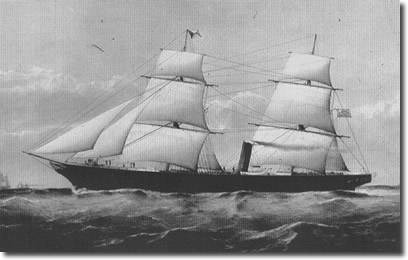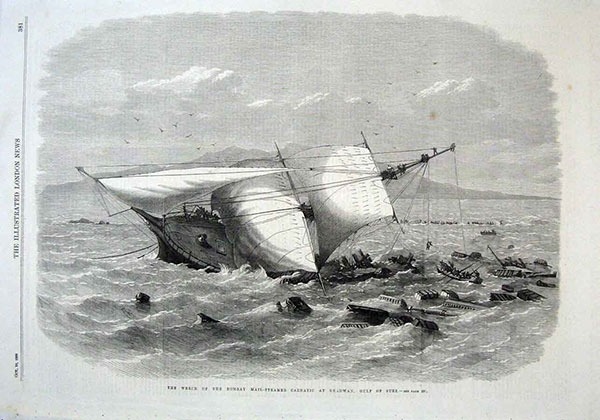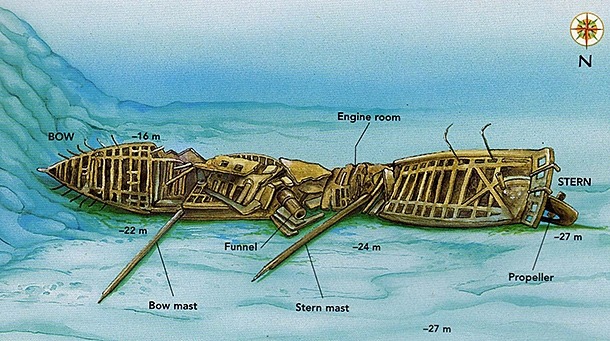The SS Carnatic
The Carnatic was built by the London based Company “Samuda Bros” and classified as an "iron sailing-steam clipper with a displacement of 1776 tons". Its dimensions were 89.8 X 11.6 meters. In addition to masts and sails, she was powered by four-cylinder 2442 hp engine.
The Carnatic was launched in December 1862 and registered in March 1863. Furthermore, on 27 June, she sailed to Calcutta and was further used for passenger services between Suez, Bombay and China.
The Carnatic was a modern and elegant vessel with luxury cabins for most wealthy passengers.
In 1867, Carnatic was placed under the command of Captain Philip Baton Jones, one of the company's most capable officers.
The last voyage

By September 1869, the Suez Canal was almost completed and was expected to open in three months. Up to this point, passengers and goods coming from Europe had been disembarked at Alexandria and from there they traveled 200 miles overland to Suez, from where they continued their voyage on another ship. Such a route was shorter and less risky than traveling around the Cape of Good Hope of Africa.
It was the second week of September 1869, and Captain Jones was preparing the Carnatic for a new voyage: he supervised the stowage of cargo and the accommodation of arriving passengers. At the start of the upcoming voyage, the ship carried 34 passengers, 176 crew members, and a cargo of cotton, copper leaf, the Royal Mail and £40,000 in gold coins destined for the Indian Mint.
On Sunday, September 12, at 10 o'clock in the morning, Captain Jones ordered the moorings to be dropped. Carnatic left Suez and began her voyage to Bombay. Captain Jones himself steered the vessel through the narrow, unforeseen dangers Gulf of Suez and did not leave the bridge. A steady speed of 11 knots was maintained, the night was clear, a light breeze was blowing and a slight fog covered the shores, but all the capes and islands were clearly visible. At 11:40 p.m., the second mate noted the passage of the Ashrafi lighthouse, and the outlines of Shedwan Island loomed ahead. A little later, the captain made small corrections to the course.
18 minutes after the correction, white foaming breakers were seen directly on the right course - the waves broke on the reef. The helm was immediately shifted and the command "full back" was given. Too late... The Carnatic swooped down on the reef and landed firmly on it.
Captain Jones remained calm. He assessed the situation, checked the condition of the ship and was even somewhat satisfied that the pumps were coping with the incoming volume of water. After talking to the crew and passengers, he decided for everyone to stay on board the ship. On the afternoon of September 13, Jones again inspected the ship. The vessel was stuck on top of a coral reef but remained in satisfactory condition. There was a leak, but with the help of pumps, the water was immediately removed overboard. Jones gave the command to throw bales of cotton overboard, in the hope that a upcoming tide would move lighter vessel from the reef. There was no panic among the passengers. One of them asked for permission to land on Shedwan Island, but Jones declined the request.
Captain Jones was well aware of the difficulties involved in moving 210 men to a remote island where there was not even water. At that moment, the ship in distress did not pose, in his opinion, a threat to the lives of passengers and crew; it had supplies of water and provisions, as well as relative comfort. He also knew that the sailing ship Sumatra, bound for Suez, was about to pass in this place and then everyone would be saved.
Tables were set for dinner, people walked along the deck. A passing ship was constantly monitored. In the evening, another delegation of passengers asked the captain to take them to Shedwan Island by lifeboats. The captain refused again. Underestimating the destructive effect of the waves on the hull of the ship, he decides to spend one more night on board. Respecting his authority, some of the ladies even changed into evening dresses for dinner. Waiters served champagne, a luxurious table was laid. For many, this dinner will be the last.
Firmly stuck on the reef, the Carnatic continued to sway, causing the holes to become more and more serious. Now her death was only a matter of time.

On September 14, at two o'clock in the morning, the water reached the steam boilers, and the lights on the ship suddenly went out. More and more passengers wanted to leave the ship, but Jones still hoped that Sumatra would come to the rescue. By dawn, the sea level began to rise, and the water began to rapidly fill the ship. Finally realizing that the ship was lost, Jones ordered the boats to be prepared.
The first passengers did not take their places in the lifeboats until eleven o'clock in the morning. Unfortunately, at this very moment it was too late. According to the tradition of that time, women and children were the first to be put into rescue boats. Only three women and a child on board managed to take their places in the boats when the Carnatic suddenly broke in half. Thirty-four hours on top of a coral reef proved to be an unbearable ordeal for an elegant sailboat. The stern quickly sank under water, taking with it five passengers and twenty-six crew members.
The bow fell to the port side and began to slide off the reef, shaking the men into the sea. The passengers and crew in the water were suddenly pulled down by a whirlpool caused by the stern sinking under the water. As soon as the boats were launched, it was time to show strength and courage. The survivors of the disaster fought together for salvation.
Passengers were pulled out of the water and taken to the shallow water above the reef, where the rest of the boats gathered. After that, everything that could be useful was fished out, and a flotilla of seven boats set sail for the island of Shedwan.
Shedwan Island lies is three miles from the edge of the vast Shaab Abu Nuhas Reef. To shorten the path, the men took turns pushing the boats across the reef. That was a hard endeavor. Never try to repeat it unless totally necessary!
The boats reached the island only after sunset.
Fortunately, several bales of cotton were dumped on the island. They were so carefully tied that they remained completely dry inside. This cotton helped to warm people who were to spend a cold night on the island. There was so much cotton that a large amount of it was carried to a hill and set on fire. In the end, Sumatra arrived and provided assistance to those in distress. Upon arrival in Suez, Captain Jones appeared before the Chamber of Commerce commission investigating the shipwreck.
Carnatic Gold
Losing £40,000 in gold coins (about £6,000,000 these days) would be unforgivable. And 2 weeks after the loss, a rescue expedition set off from Suez.
After three days of diving using a surface air supply helmet, all gold crates were found and safely lifted aboard.
There is no gold on the Carnatic. But the cargo of sheet copper remained. And for many more years, Bedouin fishermen dived on the Carnatic without any equipment and got valuable copper.
Then the reef got its name "Abu Nuhas". That is, the "Father of Copper".
Diving on the Carnatic

The most surprising thing about this wreck is that although the ship sank after being divided into two halves, these two halves then sank to the bottom as if the ship had gone under the water in one piece. Today, Carnatic is located at the foot of the reef and lies parallel to it on the port side, bow to the east. The stern and bow have been preserved almost intact. Between them is the damaged area where the ship broke in half. The engine room was located here.
The depth at which the ship lies is 25-27 meters; its upper (starboard) side is at a depth of 18-20 meters. The wooden superstructures and plank plating have long since rotted. This gives divers the opportunity to explore multiple deck levels inside the ship.
On the bow there is a large copper ring, which used to hold the bowsprit. If you look from the front, you can still see the elegant contours of the Carnatic. The hull of the ship expands from the bow to the middle part. Davits are absent on both sides. You'll be able to get inside the ship and swim between the iron beams – a thrilling encounter with a ship built in 1862!
From the front compartment, you get to the part of the wreck that is most damaged. Although it's really just a pile of metal, the middle section attracts researchers because the four-cylinder steam engine is still somewhere inside.
Most divers consider the stern to be the most interesting and exciting part of the wreck. Just like on the bow, through the davits on both sides, you can get inside the ship, and explore two levels of holds. Inside there are still old barrels. And one can only guess what they contained and what exactly could have preserved the wooden barrel staves so well. Brandy, perhaps?
However, to see the most remarkable, you need to swim out of the wreck and go around it from the back. There are seven square aft windows in a row. It's amazing how traditional styles of building wooden ships were adapted to steel structures. Under the windows, the stern gently curves down and inward, revealing a huge rudder and one detail that is definitely unusual for a sailboat - a large three-bladed propeller.
More than a hundred years have passed since the shipwreck, and now it is safe to say that in the future the ship will remain in the state in which it is now. The ship is abundantly inhabited with soft corals and reef fish, including groupers and lionfish. The Carnatic is one of the finest examples of 19th-century ships found underwater anywhere in the world. At least for this reason, it is worth a visit.
And, perhaps, you will remember those for whom this ship became the last refuge.
Postscript
After an investigation, the Chamber of Commerce ruled that the Carnatic was fully equipped with everything necessary for safe navigation. Captain Jones was recognized as an experienced sailor. Though the disaster was the result of his fatal mistake.
Jones believed that he had been blown off course by an unusually strong current. However, the court ruled that he had to take Ashrafi's lighthouse as a support in order to pinpoint his location. Jones was stripped of his captain rank for nine months.
When considering the measures taken by the captain to protect the passengers and crew after the ship had sunk, the members of the Council unanimously acknowledged that "when it was decided to abandon the ship, the captain and his crew, in an effort to ensure the safety of the passengers, did everything that experienced and courageous men would have done."
Captain Philip Baton Jones was born in Liverpool in 1830. He was commissioned captain in London in 1858, at a quite young age of 28. He commanded Columbian, Mongolia, Surat, and Syria merchants . After the loss of Carnatic, Captain Jones never went to sea again.
Abu Nuhas Reef, the Father of Medi, continued to charge its toll for passage through the Strait of Gubal right up to the present day. The largest of the ships, the Giannis D, was wrecked here in 1983. Seven wrecks lie on its slopes, but only 4 of them are accessible to divers.

 Diving in Sharm el-Sheikh
Diving in Sharm el-Sheikh